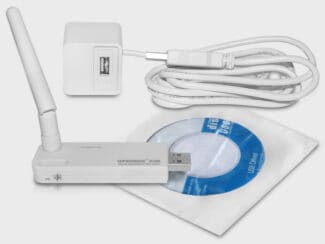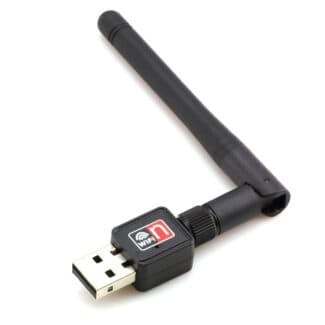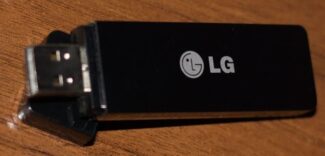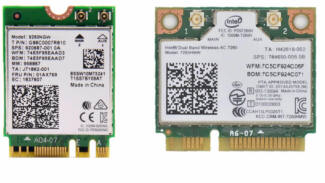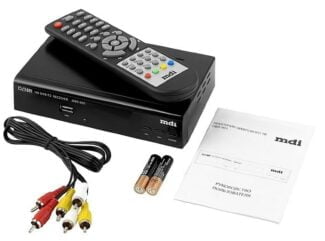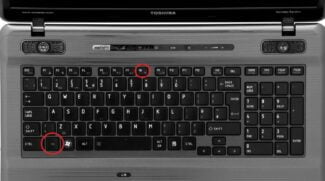LG Smart TV provide users with great opportunities: interactive viewing of hundreds of TV channels, virtual visits to online movie theaters, communication with friends through messengers, etc. Thanks to constant access to the Internet Smart TV is now a home multimedia center, a place for family recreation, communication, education, etc. For this purpose, it is most convenient to use a wireless Wi-Fi connection. It is high speed, easy connection and no wires.
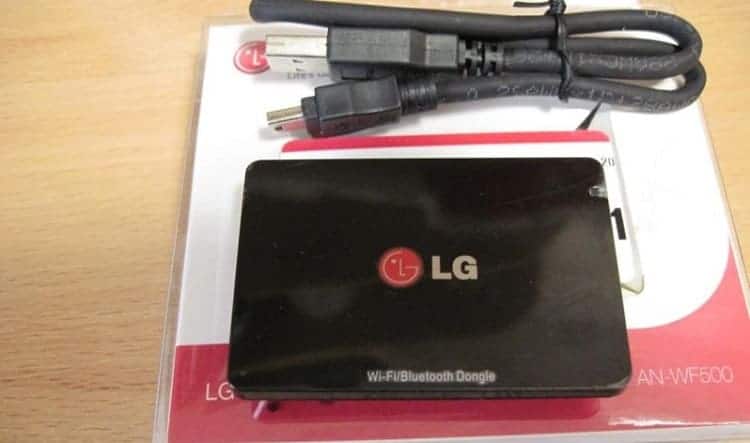
- Setting up and connecting a Wi-Fi adapter for LG TVs
- What parameters you should pay attention to when choosing a Wi-Fi adapter
- What is a Wi-Fi adapter
- How to choose an adapter for LG TV
- How to choose the right one
- The main characteristics
- TV compatibility
- Transmitter power
- Choosing a Wi-Fi adapter
- AN-WF100 Wi-Fi adapter for LG TV
- Analogues
- Little tricks
- TV connection options to the "Web"
- Setting up a cable connection
- How to boost or enhance the signal
- Router as a receiver
- How to choose a module for LG TV
- How to connect and configure the Wi-Fi adapter to the LG TV
Setting up and connecting a Wi-Fi adapter for LG TVs
Almost all models of modern TVs are equipped with a built-in module that helps you access the Internet directly, without using a cable. But you can also buy a TV without a Wi-Fi adapter, in which case, in order not to pull an Internet cable to the TV, especially if it is far from the router, a portable adapter designed for the TV will help. Today it is easy enough to purchase and install such a device – it does not take much time and effort.
To make the Internet work on a modern TV that is not equipped with a built-in module to receive Wi-Fi signal, you need to connect an external Wi-Fi adapter for LG TV. To do this, the device is inserted into a special USB connector. Such a portable module has all the features of a built-in router. Its appearance resembles a standard flash card or a small router, from which the cord goes to the connector. In either case, it does not take up much space.
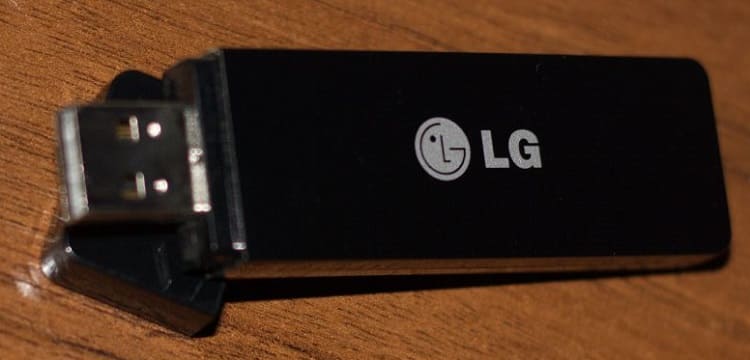
Of course, you can't buy the first module you see in the hope that it will fit into a particular model of TV and will function well, providing uninterrupted access to the Internet. You can't connect an ordinary computer device to the TV either – it simply won't work. So how not to make a wrong choice?
Manufacturers do not just recommend to use the module of the same brand as the TV, because it is impossible to install drivers, in order to ensure smooth functioning with any device. And there should be no problems with the LG adapter, because the TV is fully compatible with it from the very beginning.
So, in order to ensure that the Wi-Fi adapter for LG TV provided access to the Internet, and the signal was quality and without interruptions, you should buy the device that is recommended by the manufacturers. The list of suitable adapters for the technical characteristics is usually placed in the instruction manual of the TV. To ensure that the device does not have any complaints in the future, it is necessary to compare the technical characteristics of the router, TV and adapter.
What parameters you should pay attention to when choosing a Wi-Fi adapter
Choosing a device for Internet access, it is necessary to pay attention to the following parameters.
| Parameter | Characteristics |
| Compatibility | This parameter is one of the most important, since the LG TV simply will not work with any device. As mentioned above, if these two devices are the same brand, then there should be no problems with their work. |
| Connector | The adapter should fit easily into the socket, because when you disconnect it and then connect it tightly entering the device can damage the socket. If, on the contrary, the adapter will be loose, there may be problems with signal reception and transmission. |
| Signal Standard | Another important factor that affects the speed of the transmitted signal. The most common standards are 802.11a (54 Mbit/s maximum – real 2 Mbit/s), 802.11b (theoretical maximum 11Mbit/s – real 3Mbit/s),802. 11g (maximum 54 Mbps – real 24 Mbps) and 802.11n (maximum 300 Mbps – real 150 Mbps). Each of these standards has its own bandwidth – maximum and real. The maximum is what the device can theoretically support and the actual throughput is what the receiver actually delivers. The difference between these two values – it's not a marketing ploy, manufacturers take into account all the nuances on which may depend on the speed of the signal, and therefore the functioning of the device (walls, furniture, other radio signals, indoor plants, etc.). |
| Operating frequency | Another parameter that you should definitely pay attention to when choosing an adapter is the operating frequency, since each signal standard has its own operating frequency. If the router and the adapter have a different frequency, Wi-Fi will not appear on the TV. Usually the supported frequency range is 2.5-GHz. |
| Transmitter Power | When choosing the power you should know that the optimal work of the receiver will be provided by the transmitter, the power of which is 17 to 20dBm, if this figure is lower, then you can't hope for a good signal. Another important detail – do not allow a large discrepancy between the power of the router and the adapter, as because of this there may be areas where the signal will be poorly received or even disappear. |
| Range | When choosing the appropriate radius, it's important to take into account a few things: the distance from the Wi-Fi router to the TV and the presence of interference between them. The radius of action is usually specified in the technical specification in meters, so it is not difficult to make a calculation and choose the right one. But there is one point here – the manufacturer can specify the range of the adapter both for closed premises and for open space, and for open space interference is very difficult to take into account. But the closer all the devices are to each other, the clearer the signal will be. |
| Encryption method | An important parameter, which affects the security of both the device and the TV. Select the adapter with VPA2 or WPA protocol, as WEP is considered to be outdated. |
What is a Wi-Fi adapter
A Wi-Fi adapter is primarily a mechanism that is designed to connect to a wireless network. It only works in a certain frequency. Its tasks include receiving or transmitting a certain piece of information over the network within a certain frequency zone, as well as the Internet packet.
Such an adapter has an external and an internal antenna designed to catch and transmit the received signal. Each adapter has its own specific software. For the device to work stably you must have the correct driver software installed.
In any device, whether it is a computer, TV or smartphone, there is a special module that can receive the signal, that is, it is a receiver that catches the signal of the router. The adapter transmits the signal set by the system and then transmits it to the module, so that the person has the Internet and access to the network.
There are different variations of the adapter. It all depends on the needs of the user, as well as the goals he wants to satisfy.
How to choose an adapter for LG TV
The choice of adapter, as mentioned earlier, depends not only on the needs of the user, but also on different characteristics. During the selection, it is worth paying attention to items such as:
- Compatibility of the adapter with the TV;
- Standard signal (from which antenna is able to catch the signal);
- The range of the device;
- The algorithm used for encryption;
- At what operating frequency the device functions.
If you follow all of these criteria, then choosing the adapter for the LG TV will not be a problem. It is worth noting that to begin with, you need to re-read a lot of information about which adapters are generally compatible with TVs from the company. It's worth talking about compatibility in more detail next.
The main thing is to choose an adapter that meets not only compatibility, but also all of the above parameters. It is worth noting that the range is worth selecting the highest. When considering the encryption algorithm, you should give preference to one that closely matches the characteristics specified in the TV settings.
Operating frequency is also an important indicator. When choosing an external connection module, you should look at the frequency at which it functions. Typically, the values range from 2.5 to 6 GHz.
If you consider all of these parameters and choose a TV that fully meets them, you can achieve not only the highest signal, but also very fast. Networking and data transfer will be instantaneous.
How to choose the right one
All major technology manufacturers recommend using only their own components and additional devices. That is, if you have a Samsung TV, then it is better to buy a smart TV adapter for Samsung, for LG – only LG, and for Sony – Sony TM. Such devices are compatible with each other, they use the technical data as accurately as possible and there will be no problems with their setup.
The original wireless adapter will provide not only a connection to the global network, but also to all mobile devices. You will be able to display on the big screen any image from your smartphone, laptop or computer without using wires.
If you buy a Wi-Fi module of the same brand as your Smart TV, you will get:
- Excellent Internet bandwidth;
- Workflow compatibility;
- Proper encryption and use of the right frequencies;
- maximum signal strength and clarity;
- a good range of reception.
You will not need to delve into the technical characteristics of the module, this has already been checked by the manufacturer. But if you decide to buy a smart smart adapter from a third-party manufacturer, then pay attention to such important parameters:
The main characteristics
According to the type of connection, all Wi-Fi adapters for TV are divided into three groups:
- PCMCIA is the originally introduced PC Card standard, which was defined and developed by the International Personal Computer Association for memory cards. Today, this slot is considered obsolete and is hardly ever found in TVs.
- HDMI is a high-definition multimedia interface. It is a native audio/video interface for transmitting uncompressed video or compressed digital audio data from HDMI-compatible devices. Any modern HDTV, home theater system, game console, Blu-ray player, or receiver has such a slot. HDMI cable is also used to connect the TV tuner.
- USB – You can use these ports to view the contents of your camera, camera, flash drive, or other USB devices on your TV. Wi-Fi adapters with USB connectivity are the most popular products on the market.
TV compatibility
All quality TV adapters come in boxes or plastic packages with information on the compatibility of the device with different TV manufacturers and models.
Carefully study for which TV sets this model of wifi adapter is suitable. If only compatible brands are listed on the packaging, it means that the product will work with all models of the specified manufacturer.
Also note that if the package with the SMART TV does not come with a wireless adapter, the basic technical parameters of the Wi-Fi receiver are specified in the technical data sheet.
Transmitter power
Transmitter power is an ambiguous parameter. It is not quite easy to really determine what the range of a Wi-Fi device depends on. The transmitter power and radio wave intensity setting only works on the router side, not on the subscriber's device.
Choosing a Wi-Fi adapter
What are the differences between 3G and 4G networks: features, advantages and disadvantages
Before selecting and connecting the module to the device, the receiver must first of all fit the brand of TV. At the moment, the most popular Wi-Fi adapters for LG TV are considered several models:
- LG AN-WF100. With its help, getting access to any wireless connections is very easy. To make it work, the TV must have the NetCast feature;
- LG AN-WF500 also connects to modern mobile devices (smartphones) and the Internet.

In addition, the manufacturer recommends considering the parameters that Wi-Fi receivers have for LG:






AN-WF100 Wi-Fi adapter for LG TV
Definition and purpose of Wi-Fi adapter for Toshiba TVs
The adapter serves to establish a wireless connection of LG AV equipment to the Internet, as well as to pair devices to the home network. The following model lines are supported:
- LD5, LD6, LD7, LD8 series LCD TVs;
- PK5, PK7, PK9, PX9 series plasma televisions;
- HW300, HX350Y projectors;
- LCD televisions with LED backlighting LEX series, LX, LE54, LE55, LE58, LE59, LE7, LE8, LE9.

Analogues
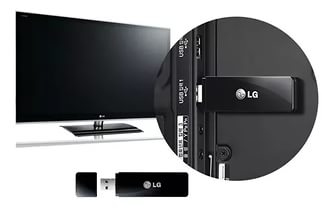
Analogous to the LG AN-WF100 is an adapter LG AN-WF500. This device is connected via a USB cable and has the same features as the previously described model.
- Ease of use. Connects via cable and does not interfere with other devices connected via USB port;
- Work with Bluetooth. Allows you to connect headphones and some other devices to the adapter, though only of a related manufacturer.
How to connect the TV to the Internet via an adapter LG AN-WF500:
That's all the settings. In the future, you do not need to connect the Internet every time. The main thing is to make sure that the adapter does not fall out of the socket.
Little tricks
It is known that not only related devices can be used for LG TV. For example, an adapter from NETGEAR can also do the job. The thing is that such adapters also use the Broadcom chip, as well as LG device manufacturers. There is a chance that your TV will accept such an adapter as a native one.
Another possibility to connect your LG TV to the Internet is a router, which can distribute and receive the Internet. All you have to do is to set it to receive and connect it to the TV via the LAN socket.
Thank you for reading to the end! If you still have questions, we'll be happy to answer them!
TV connection options to the "Web"
To access the Global Network, you'll need to run an additional cable. Ethernet channel can not be divided into digital streams and serve more than one device at a time.
Important! Many providers choose the network standard. This option uses a fiber optic connection. However, it is not supported by every Smart TV model.
To configure it, you need to insert an Ethernet cable into the LAN port of the TV device. After going to the network connection settings, you need to select "Wired" type. Once the settings are saved, you will need to reboot the TV.
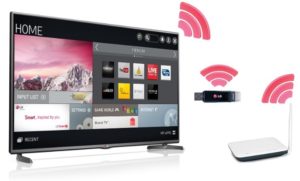
Setting up a cable connection
If the TV does not access the Network wirelessly, then you should use the LAN port of the router.
Pay attention! With a modem, you can send Wi-Fi to the TV device via Ethernet cable.
- Simple method. If the apartment already has a router with wireless network access, you only need to connect the TV and the router with a patch cord.
- Simple operation. The distribution of wi-fi occurs without fail. The network is always available.
- The speed of data exchange on the TV device is fixed significantly higher than on other devices that are connected to Wi-Fi. To determine the real speed you need to check the TV processor data.
- Save the new settings and reboot the device. After performing this simple procedure Smart TV will connect to the Global Web.
How to boost or enhance the signal
Sometimes the connection is there, but there can be problems with video interruption when the picture begins to lag. This means that the speed has sagged and packets are being lost. There are several things you can do:
- Try to position the router as close to the TV as possible.
- There should not be any significant interference in the way of the signal in the form of phones and microwaves.
- Go into the router settings. Then go into the wireless network. Make sure you have the right option under "country". This is for the device to automatically detect the communication channels used. In this way the wifi will not conflict with the radio and telephone waves according to the standard in your country. If there is no country setting, set the channel to mode: 1, 3 or 5.
- Turn the antennas toward the TV and tilt them at a 45 degree angle.
Router as a receiver
You don't have to use an adapter to connect to the network. You can install a router next to the TV. Connect one end of the cable to the TV and the other end to the router's LAN port. Then you have to configure this router as a bridge. The signal will come from the original router to the second router. In this way, you can also configure the TV, which is supplied by the Internet cable from the provider.
How to choose a module for LG TV
Despite the variety of Wi-Fi adapters on sale, not all of them can fit LG TV receivers.
The difficulty is that the operating system smart-tv WebOS does not see external modules, designed to work in the Android system.
There are several models of LG adapters on sale. Unfortunately, their price is high. Online stores offer cheaper universal devices suitable for LG televisions.
- The frequency at which the signal receiver and transmitter work. Wi-Fi devices work in two bands: 2.4 to 5 GHz. Each has its own advantages and disadvantages. Signal transmission speed with a frequency of 2.4 GHz can not exceed 300 Mbit per second. Equipment operating on this frequency is sensitive to radio interference. But the signal with a frequency of 2.4 GHz has good penetration – 2 walls in the apartment reduce its strength slightly. The 5 GHz signal is heavily attenuated by obstacles, but is insensitive to interference and provides bandwidth up to 6 GHz/s.
- Wi-Fi signal type. The most important parameter that determines the speed of data exchange in a wi-fi network. There are several standards depending on the transmission speed:
If the router and external wi-fi module operate on different frequencies, they will not be able to synchronize and exchange data. Therefore, if the specifications specify a 2.4 GHz operating frequency for routers, the external module must have the corresponding specifications.
- Radio Transmitter Power. An important factor in the smooth operation of the adapter. If this indicator does not reach 17 dBm in the device specifications, it is better to refrain from buying it. A good device should provide a signal strength of about 20 dBm.
- Encryption method. Routers use WPA, the most secure data protection protocol. Therefore, the adapter must also support this method of data encryption.
How to connect and configure the Wi-Fi adapter to the LG TV
To connect the external module to the router, you need:
- Connect it to the USB port of the TV.
- After detecting the device, open the settings menu on the TV.
- Select "Network Settings" and activate it.
The next time you turn on the TV, it will automatically connect to the router if the USB adapter is not removed.
Setting up the LG adapter takes a couple of minutes and is not difficult for the user. However, when using third-party devices, the wireless connection often does not work. First of all, a smartphone app that measures radio emission levels checks the wi-fi signal strength of the router. If the signal is weak, the devices are placed closer together, or a wi-fi signal booster is purchased. If the signal is strong, you can fix the pairing error with the following actions:
- Check that the wifi network hardware key is correctly entered to connect the LG TV to the adapter.
- Reboot the router.
- Check the radio frequencies of the router and adapter – 2.4 or 5 GHz. Select the same values.
- If the problem is not solved, enter the router settings and manually select a channel. Reboot the router and reconfigure the connection. If an error occurs, repeat the sequence of actions for each channel.
- Check the encryption settings of the router and adapter and select the same protocols.
However, even with the above recommendations third party products may not work on LG TV receivers.
Read More:
